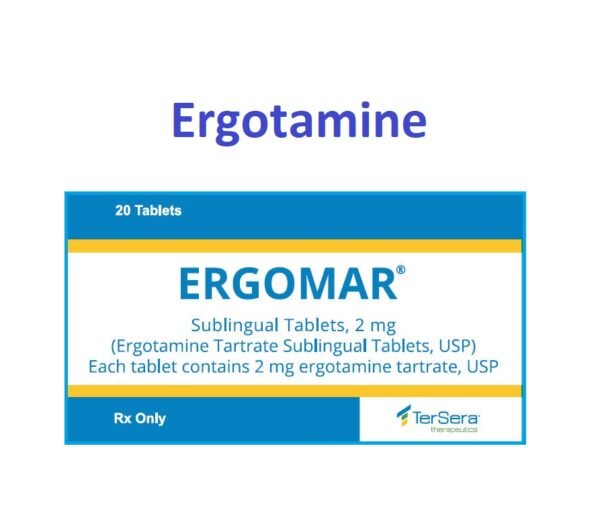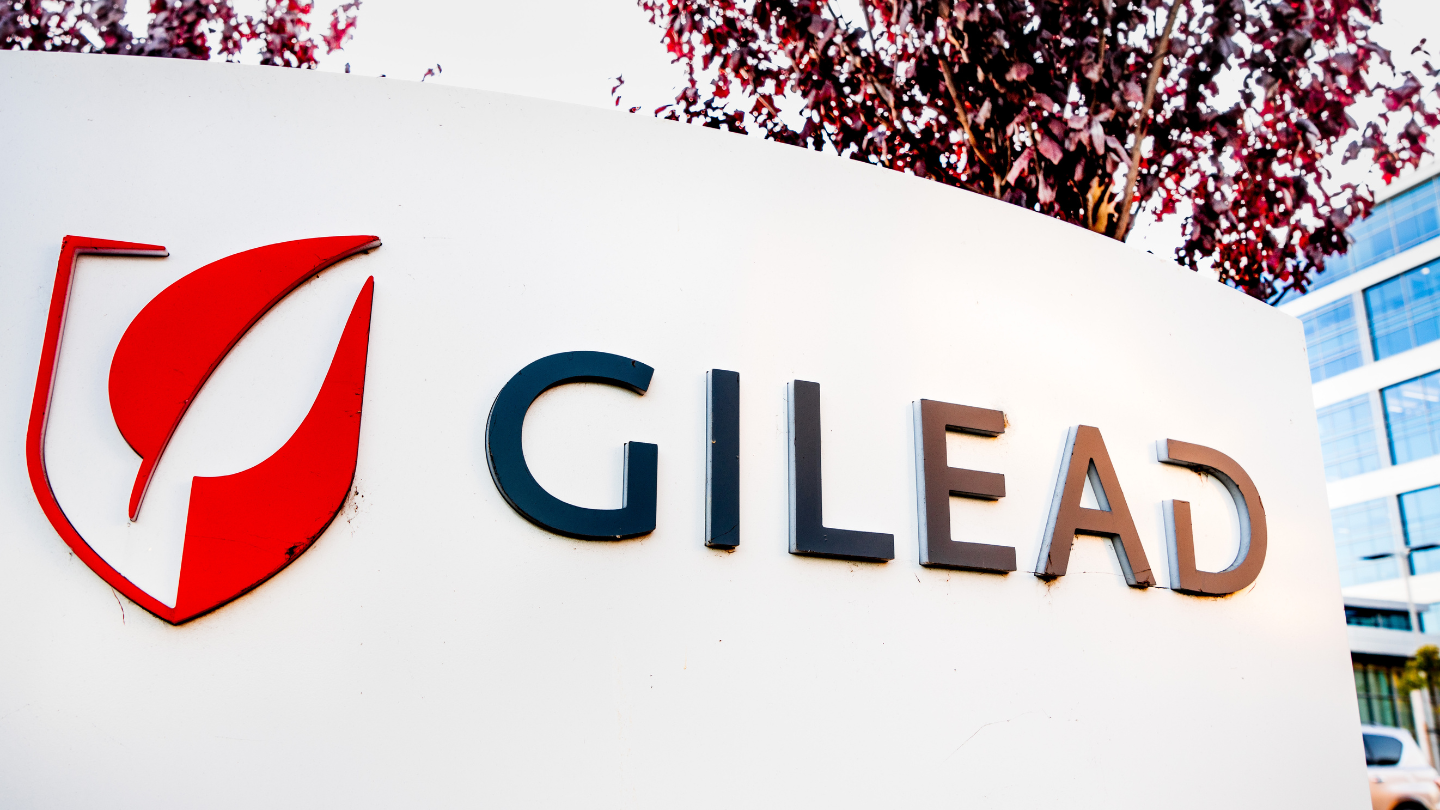Ergotamine (Ergomar) acts on the smooth muscles of the blood vessels and uterine muscles. It is used in the treatment and prevention of migraine. The drug has been associated with serious cardiovascular adverse events and should be avoided in patients with hypertension, angina, and those with risk factors for ischemia.
Ergotamine Uses:
-
Vascular headache:
- It is used to prevent vascular headaches such migraines, migraine variant headaches, and histaminic cephalgia as well as cure them when they occur suddenly.
Ergotamine (Ergomar) Dose in Adults
Ergotamine (Ergomar) Dose in the treatment of Vascular headache:
- Sublingual:
- It is administered as one tablet (2 mg) under the tongue as soon as the patient senses a sign of a migraine,
- If necessary, the dose may be repeated at a rate of 2 mg every 30 minutes, up to a daily maximum of 6 mg and a weekly maximum of 10 mg.
Ergotamine (Ergomar) Dose in Children
Ergotamine (Ergomar) Dose in the treatment of Vascular headache:
-
Adolescents:
- Sublingual:
- It is administered as 2 mg (one tablet) under the tongue as soon as the patient senses the first sign of a migraine.
- The dose may then be repeated in a dose of 2 mg (one tablet) every 30 minutes as tolerated and if required.
- The maximum dose per day should not exceed 6 mg and the maximum dose per week should not exceed 10 mg.
- Sublingual:
Note:
- It is important to note that newer antimigraine medicines are more commonly used because of better efficacy and fewer adverse effects.
- Newer antimigraine medicines used to abort the migraine attack include:
Pregnancy Risk Factor X
- It results in decreased placental blood flow by causing smooth muscle contractions in the uterine blood vessels and myometrium.
- A reduced blood supply to the foetus can cause fetal growth retardation.
Use of ergotamine while breastfeeding
- Breastmilk may contain the drug.
- This can cause vomiting, diarrhea, weaken pulse, and changes in blood pressure in the infant who is being fed.
- Sometimes, nursing or treatment may have to be stopped.
Dose in Kidney Disease:
It should be avoided in patients with impaired renal function.
Dose in Liver disease:
It is not indicated in patients with liver disease.
Side effects of Ergotamine (Ergomar):
-
Cardiovascular:
- Bradycardia
- Cold Extremities
- ECG Changes
- Edema
- Hypertension
- Ischemia
- Tachycardia
- Valvular Sclerosis
- Vasospasm
-
Central Nervous System:
- Numbness
- Paresthesia
- Precordial Pain
- Vertigo
-
Dermatologic:
- Gangrene Of Skin Or Other Tissue
- Pruritus
-
Gastrointestinal:
- Nausea
- Vomiting
-
Genitourinary:
- Retroperitoneal Fibrosis
-
Neuromuscular & Skeletal:
- Myalgia
- Weakness
-
Respiratory:
- Cyanosis
- Pleuropulmonary Fibrosis
Contraindications to Ergotamine (Ergomar):
- Allergy to any drug or component of the formulation
- Peripheral Vascular Disease
- Liver and kidney disease
- Coronary artery disease
- Hypertension
- Sepsis
- Use with some macrolide antibiotics and potent CYP3A4 inhibitors, such as protease inhibitors and azole antifungals.
- Pregnancy
Warnings and precautions
-
Cardiac Valvular Fibrosis:
- The rare association with fibrotic thickening of the aortic, mitral and tricuspid valves has been found to be caused by prolonged use of ergotalkaloids.
-
Cardiovascular effects
- Ergot derivatives affect the smooth muscles in the blood vessels, causing vasoconstriction. This could lead to hypertension and a decrease in cerebral blood flow.
- The drug can cause peripheral vasoconstriction, which could lead to angina, digital ischemia, ischemic collitis, myocardial injury, and ischemic colitis if it is used for a prolonged period.
- Patients with vascular disease should be cautious about taking ergot alkaloids.
- According to the American Heart Association (AHA), it is suspected of causing myocardial toxicemia (magnitude major).
-
Ergotism:
- Ergotamine and other alkaloids from ergot may cause severe vasoconstriction (ergotism), which may lead to peripheral vascular ischemia, which can cause gangrene in the distal parts like the fingers and toes.
- Overdosage and prolonged use can lead to ergotism. Avoid overdosing or prolonged use of the drug.
-
Retroperitoneal and pleural fibrosis
- The drug can rarely be used for prolonged periods of time.
Ergotamine: Drug Interaction
Note: Drug Interaction Categories:
- Risk Factor C: Monitor When Using Combination
- Risk Factor D: Consider Treatment Modification
- Risk Factor X: Avoid Concomitant Use
Risk Factor C (Monitor therapy) |
|
| Antiemetics (5HT3 Antagonists) | Could make serotonin modulators' serotonergic effects stronger. Serotonin syndrome might occur from this. |
| Antipsychotic Agents | Serotonin modulators might make antipsychotic drugs more harmful or toxic. Serotonin modulators, in particular, may enhance dopamine blockade, potentially raising the risk for neuroleptic malignant syndrome. Serotonin modulators' serotonergic effects may be strengthened by antipsychotic drugs. Serotonin syndrome might occur from this. |
| Aprepitant | May elevate CYP3A4 substrates' serum concentration (High risk with Inhibitors). |
| Chloroprocaine | May enhance the hypertensive effect of Ergot Derivatives. |
| Clofazimine | May increase the serum concentration of CYP3A4 Substrates (High risk with Inhibitors). |
| CYP3A4 Inhibitors (Moderate) | May decrease the metabolism of CYP3A4 Substrates (High risk with Inhibitors). |
| Duvelisib | May increase the serum concentration of CYP3A4 Substrates (High risk with Inhibitors). |
| Erdafitinib | May increase the serum concentration of CYP3A4 Substrates (High risk with Inhibitors). |
| Fosaprepitant | May increase the serum concentration of CYP3A4 Substrates (High risk with Inhibitors). |
| Fosnetupitant | May increase the serum concentration of CYP3A4 Substrates (High risk with Inhibitors). |
| Larotrectinib | May increase the serum concentration of CYP3A4 Substrates (High risk with Inhibitors). |
| Metaxalone | Could make serotonin modulators' serotonergic effects stronger. Serotonin syndrome might occur from this. |
| Methylphenidate | Serotonin modulators' harmful or toxic effects could be exacerbated. In particular, there may be an increased risk of serotonin syndrome or serotonin poisoning. |
| Metoclopramide | Serotonin modulators may intensify Metoclopramide's harmful or hazardous effects. This could appear as signs of neuroleptic malignant syndrome or serotonin syndrome. |
| Opioid Agonists | May enhance the serotonergic effect of Serotonin Modulators. This could result in serotonin syndrome. |
| Palbociclib | May increase the serum concentration of CYP3A4 Substrates (High risk with Inhibitors). |
| Reboxetine | May enhance the hypertensive effect of Ergot Derivatives. |
| Serotonin Modulators | May enhance the adverse/toxic effect of other Serotonin Modulators. The development of serotonin syndrome may occur. Exceptions: Nicergoline; Tedizolid. |
| Simeprevir | May increase the serum concentration of CYP3A4 Substrates (High risk with Inhibitors). |
| Tedizolid | Could make serotonin modulators' serotonergic effects stronger. Serotonin syndrome might occur from this. |
| TraMADol | Serotonin modulators may intensify TraMADol's harmful or hazardous effects. Seizures may become more likely. The serotonergic impact of serotonin modulators may be enhanced by TraMADol. Serotonin syndrome might occur from this. |
Risk Factor D (Consider therapy modification) |
|
| Anti-Parkinson Agents (Monoamine Oxidase Inhibitor) | Could make serotonin modulators' serotonergic effects stronger. Serotonin syndrome might occur from this. Management: If selegiline, rasagiline, or safinamide is coupled with a serotonin modulator, keep an eye out for the telltale signs and symptoms of serotonin syndrome/serotonin poisoning. It is not advised to use transdermal selegiline with serotonin modulators. |
| Beta-Blockers | Ergot derivatives' ability to constrict blood vessels might be improved. |
| CYP3A4 Inhibitors (Strong) | May slow down CYP3A4 substrate metabolism (High risk with Inhibitors). |
| Linezolid | May enhance the serotonergic effect of Serotonin Modulators. This could result in serotonin syndrome. Management: Due to a risk of serotonin syndrome/serotonin toxicity, discontinue serotonin modulators 2 weeks prior to the administration of linezolid. If urgent initiation of linezolid is needed, discontinue serotonin modulators immediately and monitor closely. |
| Macrolide Antibiotics | Ergot derivatives' serum levels can rise. |
| Stiripentol | May elevate CYP3A4 substrates' serum concentration (High risk with Inhibitors). Management: Due to the increased potential for side effects and toxicity, stiripentol should not be used with CYP3A4 substrates that are thought to have a narrow therapeutic index. Use of stiripentol with any CYP3A4 substrate necessitates closer observation. |
Risk Factor X (Avoid combination) |
|
| Alpha-/Beta-Agonists | Alpha-/BetaAgonists' hypertensive effects may be enhanced by ergot derivatives. Alpha-/Beta-Agonists' vasoconstrictive effects may be strengthened by ergot derivatives. |
| Alpha1-Agonists | Alpha1-Agonists' ability to cause hypertension may be increased by ergot derivatives. Alpha1-Agonists may have a greater vasoconstrictive impact when combined with ergot derivatives. |
| Antihepaciviral Combination Products | Ergot derivatives' serum levels can rise. |
| Clarithromycin | Ergotamine serum levels might rise. |
| Cobicistat | Ergotamine serum levels might rise. |
| Conivaptan | May increase the serum concentration of CYP3A4 Substrates (High risk with Inhibitors). |
| Crizotinib | May increase the serum concentration of Ergotamine. |
| Dapoxetine | May enhance the adverse/toxic effect of Serotonin Modulators. |
| Enzalutamide | May decrease the serum concentration of Ergotamine. |
| Fusidic Acid (Systemic) | May increase the serum concentration of CYP3A4 Substrates (High risk with Inhibitors). |
| Idelalisib | May increase the serum concentration of CYP3A4 Substrates (High risk with Inhibitors). |
| Itraconazole | May increase the serum concentration of Ergotamine. |
| Ketoconazole (Systemic) | May increase the serum concentration of Ergotamine. |
| Letermovir | Ergot derivatives' serum levels can rise. |
| Lorcaserin | Ergot derivatives' harmful or poisonous effects could be increased. More specifically, taking these medications concurrently may make you more likely to develop valvular heart disease. The serotonergic action of ergot derivatives may be enhanced by lorcaserin. Serotonin syndrome might occur from this. |
| Methylene Blue | Could make serotonin modulators' serotonergic effects stronger. Serotonin syndrome might occur from this. |
| MiFEPRIStone | Ergotamine serum levels might rise. To treat hyperglycemia in Cushing's syndrome, avoid ergotamine for two weeks before and after using mifepristone. Although neither effect has been well researched in clinical settings, the interaction magnitude may be smaller when single dosages are used to end pregnancies. |
| Nitroglycerin | Nitroglycerin's ability to dilate blood vessels may be lessened by ergot derivatives. |
| Posaconazole | Ergotamine serum levels might rise. |
| Protease Inhibitors | Ergotamine serum levels might rise. |
| Roxithromycin | Ergotamine serum levels might rise. |
| Serotonin 5-HT1D Receptor Agonists | Serotonin 5-HT1D Receptor Agonists' ability to constrict blood vessels may be enhanced by ergot derivatives. The vasoconstrictive effects of ergot derivatives may be enhanced by serotonin 5-HT1D receptor antagonists. |
| Voriconazole | May increase the serum concentration of Ergotamine. |
Monitoring parameters:
- Monitor blood pressure, pulse, and ECG
- Monitor for the response to treatment.
How to administer Ergotamine (Ergomar)?
It is not recommended to chew, break, or crush the tablets. You can take it regardless of your mealtime.
Mechanism of action of Ergotamine (Ergomar):
- It can act as an antagonist or partial agonist of alpha-adrenergic, tryptamine and dopamine receptors, depending on where they are located.
- It stimulates the contraction of the uterine muscles.
- It causes constriction in the cranial, peripheral blood vessels as well as the depression of central vasomotor systems.
Absorption:
- Absorption is erratic following oral or rectal administration.
Metabolism:
- It is metabolized extensively in the liver, including high first-pass metabolism.
Bioavailability:
- Oral, rectal: Less than 5%.
Half-life elimination:
- 2-2.5 hours.
Time to peak serum concentration after oral administration:
- 2 hours.
Excretion:
- Feces (90%), primarily excreted as metabolites.
International Brand Names of Ergotamine:
- Ergomar
- Antimigraine
- Avamigran
- Cafeton
- Caftar
- Clavigrenin akut
- Cornutamin
- Enxak
- Ergam
- ergo sanol
- Ergo-Kranit
- Ergocaf
- Ergodryl Mono
- Ergokapton
- Ergosanol
- Ergosanol SL
- Ergosanol Spezial N
- Ergotamin
- Ergotamin Medihaler
- Ergotamin ”Dak”
- Ergotamina tartrato
- Ergotaminum Tartaricum
- Ergotan
- Ergotartrat
- Gynergen
- Lingraine
- Medihaler Ergotamine
- Medihaler-Ergotamine
- Migranil
- Migretamine
- Migrexa
- RubieNex
- Secagyn
- Sydolil
- Tetralgin Haler
- Trinergot
Ergotamine Brands Names in Pakistan:
No Brands Available in Pakistan.




